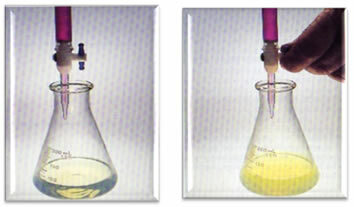In our organism, reactions essential for the maintenance of life constantly occur. For example, the nutrients in the foods we consume, such as proteins, carbohydrates and fats, are converted into other substances that we can absorb. These transformations happen too quickly thanks to the presence of enzymes.
At enzymes are protein molecules with large molar mass that act as biological catalysts, also called biocatalysts, that is, they can speed up metabolism (body reactions).
For example, a lollipop on a table will take a long time to decompose in contact with only the oxygen in the air. But when we consume it, the reaction between the sugar in the lollipop and the body's oxygen takes place in a few seconds, because the enzymes act on the sugar molecules creating structures that react more easily, accelerating the reaction.

Enzymes are highly specific, meaning that each acts as a biological catalyst for just one reaction. This is because the enzyme has an active center that combines with the compound that will undergo the enzymatic action. This compound is called
substrate. It is as if the enzyme were the key to a lock (substrate).In the scheme below, this is exemplified:

Notice that the enzyme reacts with the substrate in a specific way, creating an intermediate compound that breaks down easily, giving rise to the products. Furthermore, the enzyme is regenerated and is not consumed in the reaction, as occurs with all catalysts.
Do not stop now... There's more after the advertising ;)
An example of an enzyme that is present in the stomach is pepsin. If we put a piece of meat in contact with the pepsin, the meat will break down quickly. If instead of pepsin, we use only hydrochloric acid, which is the main component of gastric juice, we will see that the meat will take a long time to be decomposed. Therefore, the presence of this enzyme in our body is essential to break down proteins, which are the substrates of pepsin.
Another example is the transport of carbon dioxide in the human body. Inside our red blood cells there is the enzyme carbonic anhydrase which converts carbon dioxide into carbonic acid about 5,000 times faster than without its presence!
Now, an enzymatic catalysis that we can visualize in everyday life is when we hurt ourselves and we apply hydrogen peroxide over the wound. At the moment there is an intense effervescence, which is the decomposition of hydrogen peroxide. This decomposition occurs very slowly, but when we put the product in contact with the blood, an enzyme called catalase increases the reaction speed.
Also, since catalase from the blood is not consumed, the effervescence will continue as we add more hydrogen peroxide to the site.

A beneficial use of this concept is made in laboratory tests to differentiate two types of bacteria: staphylococci and streptococci. Only staphylococci contain catalase. So, in the test, hydrogen peroxide is added to the sample, if it fizzes, it's staphylococci, if it doesn't, it's streptococci.
By Jennifer Fogaça
Graduated in Chemistry
Would you like to reference this text in a school or academic work? Look:
FOGAÇA, Jennifer Rocha Vargas. "Enzyme Catalysis"; Brazil School. Available in: https://brasilescola.uol.com.br/quimica/catalise-enzimatica.htm. Accessed on June 27, 2021.

